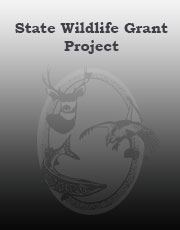Hibernating Bats in North Dakota: Species Diversity, Habitat Use, and Potential Impacts of White-Nose Syndrome (SWG T-35-R)
White-nose syndrome (WNS) is an emerging infectious disease that is having devastating effects on hibernating bat populations in the northeastern United States. Originally discovered in upstate New York in 2007, the disease has rapidly spread South and West. Mortality rates are greater than 75% and often reach 100%, with the estimated death toll from WNS in North America at more than 5.5 million bats. From a conservation perspective, this research will provide baseline information about overwintering populations of bats in the state. This is especially critical if, as predicted, WNS spreads to North Dakota in the near future. Specifically, we expect that from our results we will be able to identify key features of selected hibernacula, characterize the activity patterns of hibernating bats. This study will also establish a protocol for monitoring hibernacula sites for the presence of WNS, so that managers can rapidly respond to the presence of the disease if it arrives in the area. The results of this study will build upon our previous research investigating the distribution and summer habitat use of bats in North Dakota. Also, a Bat Management/White-nose Syndrome Response Plan for North Dakota will be developed.

